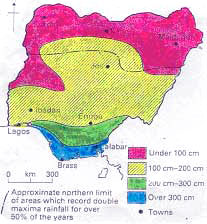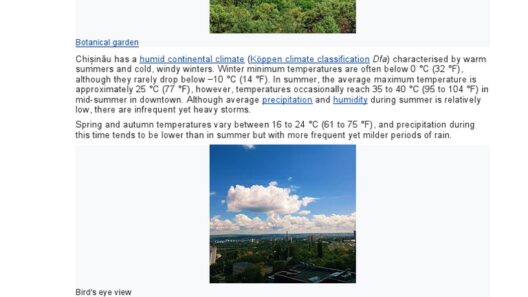Nigeria, a country nestled in the heart of West Africa, exhibits a distinctive tropical climate characterized by diverse ecological zones and weather patterns. This enthralling climate manifests primarily through two distinct seasons: the wet and dry seasons. As one contemplates the weather of Nigeria, one might playfully wonder, what if everyone could predict the rain like a seasoned farmer? Such insight could revolutionize not only agricultural practices but also daily life in this vibrant nation.
To understand Nigeria’s climate better, it is essential to first delve into the various climatic regions that span the country. Nigeria is not a monolithic landscape; it comprises numerous ecological zones, each with unique characteristics shaped by factors like topography and proximity to water bodies. The country is generally divided into three primary climate zones: the humid tropical zone in the south, the tropical savanna in the central region, and the arid climate in the northern parts.
The southern regions of Nigeria enjoy a humid tropical climate, characterized by significant rainfall and high humidity levels throughout much of the year. This region, which includes cities such as Lagos and Port Harcourt, experiences its rainy season from April to October. The rainfall can be particularly intense, with downpours sometimes reaching torrential levels, leading to issues like flooding. On the other hand, the dry season is marked by the harmattan, a dry and dusty trade wind that sweeps in from the Sahara, usually between November and March.
As one moves northward, the climate transitions into the tropical savanna, where distinct wet and dry seasons exist. This zone is known for its grasslands, scattered trees, and significant agricultural activities. The wet season typically occurs from May to October, with farmers diligently planting their crops during this time to take full advantage of the nourishing rains. However, the dry season poses a challenge, with water scarcity and drought emerging as pressing concerns, particularly for livelihood-dependent communities.
Furthest north lies the arid climate zone, where the harsh reality of desert conditions prevails. Here, cities like Kano and Sokoto experience scorching temperatures that can soar above 40 degrees Celsius in the hottest months. The rainy season is scant, beginning in June and concluding around September, but even then, precipitation is minimal and often unpredictable. The stark contrast in climate and resources between the north and southern regions of Nigeria highlights the disparities that exist within the country.
A crucial element of Nigeria’s climatic narrative is its susceptibility to climate change and its ramifications. The juxtaposition of Nigeria’s rich biodiversity and its vulnerability to climate variability raises alarming questions about the future. How will shifts in precipitation patterns and rising temperatures affect food security and the livelihoods of millions of Nigerians? The specter of climate change looms large, demanding urgent measures to adapt and mitigate its effects.
One of the most pressing challenges faced by Nigerian farmers is the unpredictable nature of the rainy season. Crop cultivation heavily relies on consistent rainfall, and any deviation can lead to devastating consequences. For instance, farmers planting their maize and cassava might find their fields parched if the rains are late or insufficient, leading to reduced yields and economic hardship. This cycle can instigate food insecurity, exacerbating existing tensions and pressures on resources.
Moreover, Nigeria’s vast network of rivers, including the Niger and Benue rivers, play a critical role in its climate and agricultural landscape. The seasonal flooding experienced in the southern regions can both nurture and destroy. While the floods replenish the soil with vital nutrients, they also pose risks of erosion and displacement. The dichotomy of nutrient-rich floodwater versus destructive deluge presents a complex challenge that necessitates effective management practices.
Urbanization further complicates the climate narrative in Nigeria. Rapid population growth has resulted in sprawling cities that often lack the necessary infrastructure to cope with seasonal rains. Urban flooding has become increasingly common, leading to significant damages, public health concerns, and disruptions to daily life. Addressing the challenges posed by rapid urbanization while ensuring sustainable development requires multifaceted approaches that incorporate climate adaptation strategies.
Despite these challenges, Nigeria’s climate also presents unique opportunities for innovation and resilience. Traditional agricultural practices are being enhanced through the integration of climate-smart technologies. Initiatives aimed at improving irrigation, promoting drought-resistant crops, and utilizing precision farming techniques are gaining traction. Moreover, community engagement and education play pivotal roles in fostering adaptive capacity among farmers and local communities.
In conclusion, Nigeria’s climate is an intricate tapestry defined by its diversity, challenges, and opportunities. The interplay of wet and dry seasons encapsulates the nation’s intricate relationship with nature. It is imperative to recognize that as climate change continues to exert its influence, proactive measures must be adopted to nurture the environment and secure the futures of generations to come. While the question of weather prediction remains playful, addressing climate issues demands serious contemplation and collective action. Will Nigeria rise to meet these challenges, ensuring sustainability and resilience for its people? Only time will tell.








